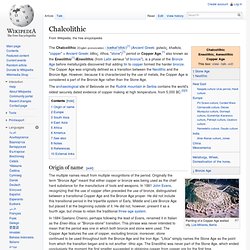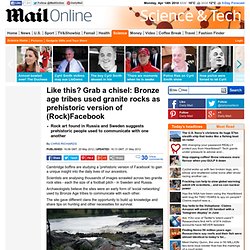

Bronze Age. Diffusion of metallurgy in Europe and Asia Minor.

The darkest areas are the oldest. The Bronze Age is a time period characterized by the use of copper and its alloy bronze and proto-writing, and other features of urban civilization. The Bronze Age is the second principal period of the three-age Stone-Bronze-Iron system, as proposed in modern times by Christian Jürgensen Thomsen, for classifying and studying ancient societies. An ancient civilization is defined to be in the Bronze Age either by smelting its own copper and alloying with tin, or by trading for bronze from production areas elsewhere. Copper-tin ores are rare, as reflected in the fact that there were no tin bronzes in western Asia before the trading in bronze began in the third millennium BC. Bronze Age cultures differed in their development of the first writing. History[edit] Near East[edit] Southwest Asia / Middle East. Chalcolithic. Origin of name[edit] In 1884 Gaetano Chierici, perhaps following the lead of Evans, renamed it in Italian as the Eneo-litica, or "Bronze-stone" transition.

This phrase was never intended to mean that the period was one in which both bronze and stone were used. The Copper Age features the use of copper, excluding bronze; moreover, stone continued to be used throughout both the Bronze Age and the Iron Age. "Litica" simply names the Stone Age as the point from which the transition began and is not another -lithic age. The Eneolithic was never part of the Stone Age, which ended conclusively the moment the first smelter succeeded in obtaining copper from copper ore for the first time.
Subsequently British scholars used either Evans's "Copper Age" or the term "Eneolithic" (or Aeneolithic), a translation of Chierici's eneo-litica. The period is a transitional one, but does not stand outside the traditional three-age system. Europe[edit] South Asia[edit] East Asia[edit] Africa[edit] America[edit] Even cavemen used social networks! Bronze age tribes used granite rocks as prehistoric version of Facebook. Rock art found in Russia and Sweden suggests prehistoric people used to communicate with one another By Chris Richards Published: 16:06 GMT, 20 May 2012 | Updated: 16:13 GMT, 21 May 2012 Cambridge boffins are studying a 'prehistoric version of Facebook' to gain a unique insight into the daily lives of our ancestors.

Scientists are analysing thousands of images scrawled across two granite rock sites - each the size of a football pitch - in Sweden and Russia. Archaeologists believe the sites were an early form of 'social networking' used by Bronze Age tribes to communicate with each other. The site gave different clans the opportunity to build up knowledge and share tips on hunting and other necessities for survival. Messages: The Namforsen rock art in Sweden has been described by academics as a prehistoric form of Facebook Artwork: Animals, humans, boats and hunting parties are among the images painted on the rocks in Sweden 'People would create art as an open invitation, it's accumulative.